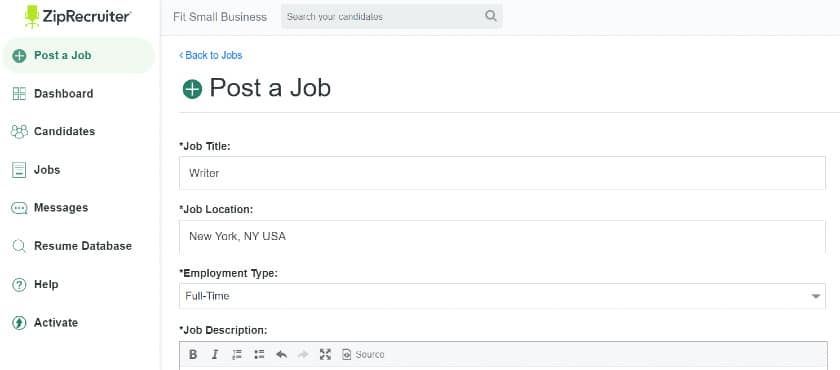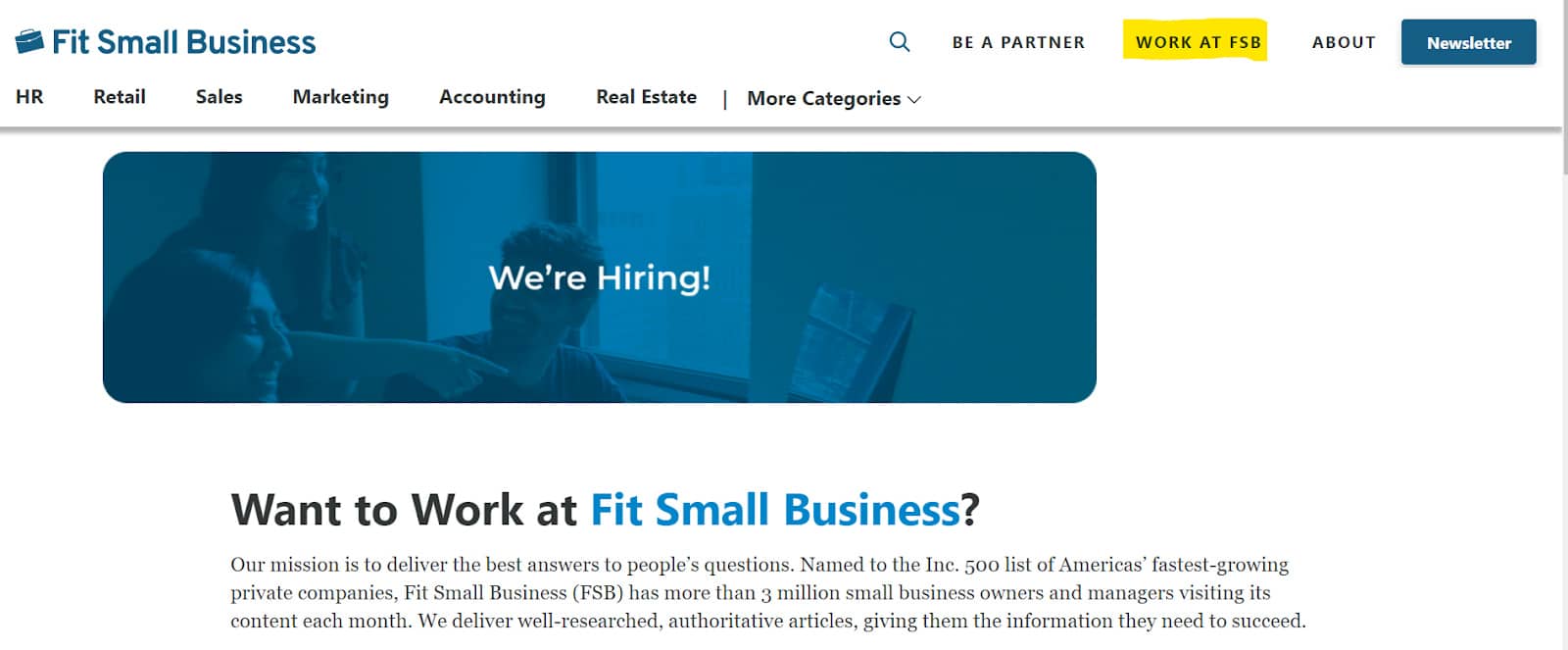To find the best candidates for your company’s open roles, you should evaluate internal vs external recruitment. Internal recruiting is when you fill an open position from within your current bank of employees by promotion or transfer. External recruiting entails posting job ads to hire a candidate that does not currently work for your company.
When looking for your next hire, if you find that you are unable to recruit from within, consider an external recruiting source like ZipRecruiter. With ZipRecruiter, you can follow your candidates through the entire hiring process—from applicant tracking to interviewing—starting at $16 per job post per day. Start now with a free trial, plus get an Exclusive Free Highlight Enhancement ($60 value) to help your posts stand out.
Internal Recruiting
Internal recruiting involves looking at the employees that currently work for you and seeing where you can move or promote them into a position you are trying to fill. This generally works because you already know the person’s work ethic and that they fit in with your company culture. Additionally, they’re familiar with your company policies and will require less training on processes typically covered in new hire onboarding.
Advantages & Disadvantages of Internal Recruiting
There are many advantages to hiring internally—it is cheaper, saves time, and can increase overall employee engagement. The disadvantages of internal recruiting include missing out on potential expertise and still having to hire for the position the internal recruit is leaving.
| PROS | CONS |
|---|---|
| Lower costs to hire | May miss out on highly qualified external candidates |
| Employee already has inside knowledge and experience with processes and procedures | Potential disappointment and disengagement from applicants not selected |
| Increases employee engagement | Have to backfill the selected employee’s previous role |
Internal recruitment may also boost employee morale. Your employees see firsthand that you value them and their contribution to your organization, even if you select someone else for the role. Besides that, letting an employee develop their career or putting them in a better-suited role can positively impact employee turnover.
If you have qualified candidates internally, there may be no reason for you to go through the extra steps of hiring from outside your organization. As such, hiring from within can be a quicker process—the average time to hire candidates internally is two to three weeks. However, there are also disadvantages, such as having a smaller pool of candidates and then having to fill in the position of the one shifting roles.
Hiring Costs
Internal recruitment costs are considerably less than those for external hiring, as you’ll be able to do away with many of the typical costs associated with the hiring process. You’ll also save a lot more time because you can focus on determining skills and qualifications rather than having to filter one’s cultural fit. On top of all that, the overhead cost of any salary increase that you’ll provide an internal candidate is typically less than that of what you’d have to shell out for a new hire.
Internal hiring costs involve the following:
- Internal job posting: Cost is equal to the hourly rate of the HR representative that creates the post.
- Job description: Cost is equal to the hourly rate of the HR rep and any supervisor that must create the job description.
- Salary increase: Cost is subjective depending on how much of an increase the internal hire will receive for the new position.
- Training: Cost is equal to the hourly rate of the supervisor who will train the internal hire in their new position.
Did You Know?
Internal hiring can also save costs on salaries. A LaborIQ study showed that new hires are paid more than current workers in the same role—an average of 7% more, which can increase to up to 20% more in tech fields.
Internal Recruitment Methods
Internal recruiting focuses more on the job skills and requirements, whereas external recruiting will need to have more emphasis on your company.
There are three key ways internal hires make a move within your company:
This occurs when you move someone within your company from one position to another—generally from a lower-level job to a higher-level job. This happens most often in a private company situation where a junior executive may be promoted to a senior position within the same department.
If you have a person in mind for the open position, that should be a promotion. By making it a promotion, you can avoid posting an open job.
This occurs when you have a new position or a position that is currently open that is not intended for an employee’s promotion. Posting the job for the entire company to see gives every employee the opportunity to apply.
In today’s electronic world, you can make this job posting an email to the whole company instead of physically posting it on a bulletin board or job board. Ensuring that every employee is aware of the job opening is important to avoid potential claims of discrimination.
A transfer occurs when you bring in a current employee from a different company location. This happens a lot in a retail environment where an employee from one store location will be moved to another store.
A transfer is generally a lateral job move and does not require a raise in pay. However, to make the move more enticing, we recommend that you offer some monetary compensation. If it’s between cities or different states, adding in a relocation bonus could be a good idea.
External Recruiting
External recruiting is when you hire a new employee who does not currently work for you. This involves posting your job on a job board or finding your next hire at a career fair, typically taking around one to three months to do. However, depending on the skills you need for a particular role, filling the position may take you much longer.
Advantages & Disadvantages of External Recruiting
Hiring externally opens your job search up to a multitude of job seekers, which can result in higher-quality candidates. Alternatively, not knowing a candidate’s work ethic and whether or not they will catch on quickly to your operating procedures can be a downfall of external recruiting.
| PROS | CONS |
|---|---|
| Nearly limitless pool of candidates | You don’t know the employee’s work ethic |
| New hires can bring a refreshing change to companies | Existing employees may feel passed over and become resentful |
| May attract high-quality talent from competitors | New hires may have a larger learning curve than internal hires |
External recruitment is a labor-intensive process. Although—or because—you get access to a limitless pool of candidates, it can take an immense amount of time to sort through them all. And you’re never completely sure you have made the right hiring decision until later down the line.
Did You Know?
A recent Gallup study found that it took external hires a minimum of 12 months to fully integrate with their new company culture and hit “peak performance” in their role. This doesn’t mean you should avoid external candidates, but you should be prepared to give them substantial time to get comfortable in their new job.
Hiring Costs
The costs to hire externally vastly outweigh the costs to hire from within—ranging anywhere from $1,000 to over $5,000 per hire, in addition to the new hire’s salary amount. External recruitment costs can also rise depending on the complexity of the position.
External recruitment costs include the following:
- Job board fees
- Sorting through applicants
- Holding multiple rounds of interviews
- Conducting prior employment and background screening
- Training and onboarding
- Compensation and benefits (including sign-on bonuses, if applicable)
External Recruitment Methods
There are many different ways to recruit an external candidate, ranging from posting an ad on job boards to searching for candidates at career fairs.
With external recruitment, be sure to shift your job description slightly to better market your company and the role. External candidates may not be familiar with your company and will want to know what benefits you offer and why they should choose your organization as their employer.
Job boards are the number one resource for employers to post open job positions and for candidates to find potential new employment opportunities.
There are several ways you can share your job ads, including the following:
- Paid job boards: With a paid job board, such as ZipRecruiter, you’ll get more than just a job listing. Most paid job boards include applicant tracking, questionnaires, skills tests, interview scheduling, and more.
- Free job boards: Using free job posting sites can increase the chances of reaching top-qualified candidates without costing anything out of pocket.
- Niche job boards: By using a job board that focuses on a specific industry or people group, such as diversity job boards, you can narrow down your search to a candidate that may be most qualified for your open positions.

Explore our What Is ZipRecruiter article to learn more about its features and pricing and access a video on how to post a job ad using this platform.
Your current employees can provide potential new hires by suggesting friends or colleagues that may have the skills required to fill your open positions. Using employee referrals gives you access to higher-quality candidates because most employees will only refer a candidate they believe will excel in the position.
Did You Know?
According to top recruiting statistics, a referred candidate is 85% more likely to be hired. This may be directly related to the trust an employer has with their current employees.
Sometimes employees will refer a candidate that may not be looking for a job. These are considered passive candidates—those who are happy in their current role but are willing to entertain excellent new opportunities. You will need to reach out to these candidates and show them why your opportunity and business will benefit them in their careers.
Attending job fairs is a great way to find top candidates while showcasing your company. These can be either online or in-person career fairs.
- Online job fair: For online job fairs, you will present your company in content format for potential candidates to read and explore. There may also be virtual interview opportunities with online job fairs.
- In-person job fair: With an in-person career fair, you will likely have a booth set up in a large open-floor-plan room. In such events, you can showcase your company with visuals and speak face-to-face with potential candidates.

Job fairs can result in hundreds of potential candidates.
If you hire frequently throughout the year, you should have a career page on your company website. Candidates typically visit a business’s web page to learn more about its company and culture. Having a career page where candidates can apply directly may increase your chances of hiring a top professional.

A great career page is easy to find on your website and highlights your company’s mission and culture immediately.
If you need tools to help with external recruiting, check out our top recruitment software picks.
Legal Considerations
As with anything having to do with employees, job postings, interviewing, and hiring decisions, whether you hire internally or externally, you are subject to employment laws. Specifically, your job postings, interviews, or hiring decisions cannot be unfairly influenced by an applicant’s:
- Age
- Citizenship
- Race
- Disability
- National origin
- Religion
- Sex
- Military service
Federal law prohibits discrimination based on the above classes, as this can lead to hiring bias. Some state laws go even further and prohibit discrimination based on a candidate’s appearance (e.g., tattoos and piercings) and marital status. Make sure you are adhering to federal law and any local employment laws applicable to your organization.
When to Choose Internal vs External Recruitment
When deciding between internal vs external recruitment, it’s crucial to consider factors such as time constraints and skill requirements. Internal recruitment tends to be faster since there is no need for lengthy onboarding or orientation periods. However, if you require specialized skills or expertise that are not readily available within your current talent pool, external recruitment may be the better option.
Internal Recruiting | External Recruiting |
|---|---|
Need to fill a position immediately | Long-term objectives |
Smaller budget | Specialized role that needs specific skills or qualifications |
Current employees are ready to be promoted | Brand new role that cannot be filled from within |
Limited resources for training | Need fresh perspective or ideas |
Bottom Line
In your hiring efforts, you may find that for some positions, internal candidates offer what you need, creating a faster, smoother, and more cost-effective hiring process. For other positions, you may need to look outside your current employee group, which can bring new skills, experience, and ideas into your company. By understanding the differences between internal vs external recruiting, as well as each method’s advantages and disadvantages, you can take the most efficient approach to find employees you’ll love.

Social recruiting (such as through LinkedIn or Facebook) are excellent places to post job ads and find your next top candidate. These platforms allow you to find and connect with skilled professionals in your industry.
LinkedIn allows you to write a detailed job description and add the required skills.